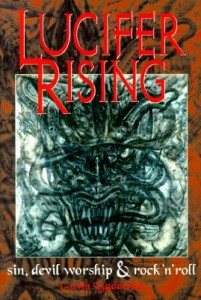 Since I initially began researching my first book, Lucifer Rising, some twenty years back, much has changed in the world of devilment. Satanism was still very much sub rosa, partially due to the Satanic Panic, then still being promoted by the opportunistic morons in the media and therapy industry, which understandably made many circumspect about announcing their infernal credentials. But now, in the UK at least, the slavering lynch mobs have long since turned their attentions to the light entertainment industry (doubtless much to the relief of organised religion, which actually does appear to be a nest of paedophiles). But other things have changed too. It is now not only far safer to declare your allegiance to the Devil, but technological developments have also made it far easier, with everything from the Internet to self-publishing removing any filtering system that might previously have kept less dedicated, more dubious diabolists off the radar.
Since I initially began researching my first book, Lucifer Rising, some twenty years back, much has changed in the world of devilment. Satanism was still very much sub rosa, partially due to the Satanic Panic, then still being promoted by the opportunistic morons in the media and therapy industry, which understandably made many circumspect about announcing their infernal credentials. But now, in the UK at least, the slavering lynch mobs have long since turned their attentions to the light entertainment industry (doubtless much to the relief of organised religion, which actually does appear to be a nest of paedophiles). But other things have changed too. It is now not only far safer to declare your allegiance to the Devil, but technological developments have also made it far easier, with everything from the Internet to self-publishing removing any filtering system that might previously have kept less dedicated, more dubious diabolists off the radar.
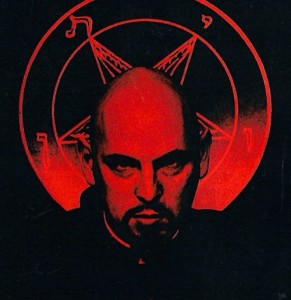 It was something that Anton LaVey – the 20th Century’s foremost Satanist – touched upon when I interviewed him for my book all those years ago. “The Satanic scene is really too nebulous to pin down,” he told me. “The loquacious ones are like the drunk at the end of the bar who’ll try and pin you down so he can fill you full of crap – we get stacks of that type of material every week. There are a lot of armies of one out there, a lot of coffee bar revolutionaries. New information technology has bred a lot of desktop Satanists and bulletin boards mean that cyberspace seems to be just full of Satanists. The Christian heretics rarely get much further than designing letterheads. But many Satanists are quietly applying Church of Satan philosophy to their lives in their own fashion in a very real way. The best thing we could ask for from those people is a passing nod of respect. We’re not joiners.”
It was something that Anton LaVey – the 20th Century’s foremost Satanist – touched upon when I interviewed him for my book all those years ago. “The Satanic scene is really too nebulous to pin down,” he told me. “The loquacious ones are like the drunk at the end of the bar who’ll try and pin you down so he can fill you full of crap – we get stacks of that type of material every week. There are a lot of armies of one out there, a lot of coffee bar revolutionaries. New information technology has bred a lot of desktop Satanists and bulletin boards mean that cyberspace seems to be just full of Satanists. The Christian heretics rarely get much further than designing letterheads. But many Satanists are quietly applying Church of Satan philosophy to their lives in their own fashion in a very real way. The best thing we could ask for from those people is a passing nod of respect. We’re not joiners.”
If the excess of clueless demoniac dunderheads and black metal blowhards was an issue then – when the Internet was very much in its infancy – it’s become worse by at least sixfold in the 21st Century. Researching Lucifer Rising the real problem was tracking down the significant figures – back then a process largely involving numerous postage stamps and fat phone bills – and then convincing them to speak to me. Anyone trying to keep abreast of the Satanic scene these days is faced more with the challenge of filtering out the superfluity of static and bullshit from legions of dubious diabolists, most of whom seldom seem to shut up. Yet worthwhile material does continue to surface for those with their infernal antennae attuned to the right frequencies. Material like the Satanic Mojo project by the British artist Jason Atomic, which his fellow artist and resident exploitation movie guru at Bizarre magazine, Billy Chainsaw, drew my attention to recently.
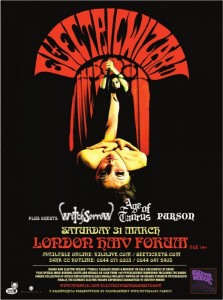 There seems to have been a surge of interest in ‘psychedelic Satanism’ of late, a fascination with reinventing the axis of dark occultism and the hippie movement in the late 60s-70s as it should have been, rather than as it actually was, most notably via bands like Electric Wizard. In point of fact, the hippies and Satanists largely didn’t see eye-to-eye then – or indeed since – more often daggers-drawn than bosom buddies. Yet, just as culture often makes the Nazis part of Weimar decadence in 1930s Berlin, rather than its opponents, so modern myth has rewritten West Coast freaks and Satanists of the 1960s as collaborators rather than antagonists. Jason’s Satanic Mojo occupies such territory, self-consciously myth-making to create a legend, which he can then manifest in various ways. And Mr Atomic’s certainly given the nod that LaVey requested, and has embarked on an intriguing journey, which I resolved to ask him more about…
There seems to have been a surge of interest in ‘psychedelic Satanism’ of late, a fascination with reinventing the axis of dark occultism and the hippie movement in the late 60s-70s as it should have been, rather than as it actually was, most notably via bands like Electric Wizard. In point of fact, the hippies and Satanists largely didn’t see eye-to-eye then – or indeed since – more often daggers-drawn than bosom buddies. Yet, just as culture often makes the Nazis part of Weimar decadence in 1930s Berlin, rather than its opponents, so modern myth has rewritten West Coast freaks and Satanists of the 1960s as collaborators rather than antagonists. Jason’s Satanic Mojo occupies such territory, self-consciously myth-making to create a legend, which he can then manifest in various ways. And Mr Atomic’s certainly given the nod that LaVey requested, and has embarked on an intriguing journey, which I resolved to ask him more about…
[All art below, courtesy of Jason Atomic, except two portraits of the artist: B&W (with naked lady) (c) the Schleyer Archive, colour shot (in hoodie) (c) Billa]
How seriously are you taking your subject? Your tone’s often satirical, but you’re also clearly fascinated by Satanism and the occult…
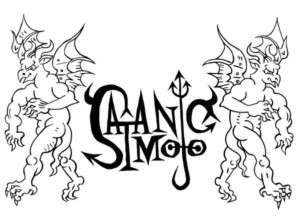 On one hand I’m having a laugh and on the other I am deadly serious. It seems to me that the only people who can really get away with telling the truth these days are comedians and science fiction writers, so it is far easier to discuss controversial topics with one’s tongue firmly in cheek. For as long as I can recall I have been fascinated by Satanism and the occult. Maybe it’s because I wasn’t raised a Catholic, but that stuff never frightened me. Growing up in the 70s I went from Scooby Doo and Egyptian mythology as an infant into Heavy Metal and underground comics in my teens, via Hammer Horror films and Marvel horror comics like Dracula Lives.
On one hand I’m having a laugh and on the other I am deadly serious. It seems to me that the only people who can really get away with telling the truth these days are comedians and science fiction writers, so it is far easier to discuss controversial topics with one’s tongue firmly in cheek. For as long as I can recall I have been fascinated by Satanism and the occult. Maybe it’s because I wasn’t raised a Catholic, but that stuff never frightened me. Growing up in the 70s I went from Scooby Doo and Egyptian mythology as an infant into Heavy Metal and underground comics in my teens, via Hammer Horror films and Marvel horror comics like Dracula Lives.
I have studied the history of witchcraft and seen how people like me have been persecuted throughout history, and indeed continue to be persecuted in many parts of the world. I don’t just mean self-styled witches, but anyone with the guts to stand up for their own convictions, to step away from the herd. Witches, philosophers, doctors, artists, hedonists even have been on the hit list of everyone from the Inquisition to the Nazis, even the Daily Mail. When I performed with the electropunk group Fist Fuck Deluxe, we used to paint stripes on our shirts concentration camp style to remind us how lucky we were to be free and how fragile and precious that freedom really is.
You identify yourself as a Satanist – what does that mean in your terms – do you have much contact with other Satanists?
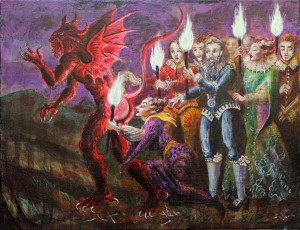 On the latest UK census I was one of 1,893 people to describe myself as a Satanist. Forget the horror movie clichés, that whole inverted Catholic mass business is ridiculous to me. I still enjoy that imagery in a cheesy, nostalgic, retro porno kind of way – I think the Malleus Maleficarum was probably porn for 14th Century monks – but I don’t go around saying the Lord’s Prayer backwards or any of that mumbo jumbo. The monotheist obsession with right and wrong is based on the archaic rules of ancient desert-dwelling nomads, and has little or no relevance to the world of today.
On the latest UK census I was one of 1,893 people to describe myself as a Satanist. Forget the horror movie clichés, that whole inverted Catholic mass business is ridiculous to me. I still enjoy that imagery in a cheesy, nostalgic, retro porno kind of way – I think the Malleus Maleficarum was probably porn for 14th Century monks – but I don’t go around saying the Lord’s Prayer backwards or any of that mumbo jumbo. The monotheist obsession with right and wrong is based on the archaic rules of ancient desert-dwelling nomads, and has little or no relevance to the world of today.
As far as I’m concerned, their charity is patronising, arrogant and passive-aggressive. Loving my enemy is just nonsensical. I think the Process Church of The Final Judgement got that one right when – to paraphrase massively – they said if a true Christian loves his enemy then he should worship Satan. What else do the monotheists offer us? Emotional blackmail, women treated as chattels – a combination of house slaves and ‘brood mares’ – ritual mutilation of children, fear, subordination, the threat of eternal damnation! The worst of it being the kind of stuff they accuse Satanists of. It is all pretty disgusting to me and so I take a position of opposition.
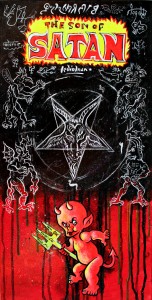 Satan is the adversary, and as an old punk sedition is in my veins, I actively encourage the fall of corrupt religious and political systems. Although I’m not a card-carrying member, I think of myself a Satanist more in the Church of Satan sense of the word. LaVey put forward a very sane, fair and human code of conduct when he wrote his Nine Satanic Statements. The idea that man is the only god makes sense to me. Religious people follow commandments without question because they are afraid of punishment. The Satanist sets their own code and takes responsibility for their own actions. I also like the idea of using such a heavily loaded name – and associated symbolism – to distance myself from stupid people. In a way I’d say Satanists are atheists with attitude. We deny god but still have non-scientific leanings towards magick and ritual.
Satan is the adversary, and as an old punk sedition is in my veins, I actively encourage the fall of corrupt religious and political systems. Although I’m not a card-carrying member, I think of myself a Satanist more in the Church of Satan sense of the word. LaVey put forward a very sane, fair and human code of conduct when he wrote his Nine Satanic Statements. The idea that man is the only god makes sense to me. Religious people follow commandments without question because they are afraid of punishment. The Satanist sets their own code and takes responsibility for their own actions. I also like the idea of using such a heavily loaded name – and associated symbolism – to distance myself from stupid people. In a way I’d say Satanists are atheists with attitude. We deny god but still have non-scientific leanings towards magick and ritual.
I don’t really seek out the company of self-proclaimed Satanists. Just because you call yourself something doesn’t make you it. I’m more concerned with the way people behave than what they profess to believe. I’m attracted to honesty, individuality, love of life, strength of conviction. I have a friend who is a bishop, I’m sure he would think of himself as a Christian yet by my understanding of the word he seems quite Satanic…
What do you make of the bleaker, more nihilistic – I’d argue monochrome – version of Satanism popularised by many of the Black Metal bands of the past decade?
Black Metal musicians are deadly serious and dedicated musicians, but their work leads them into some very bleak territory. Mostly they tend to keep themselves to themselves and we only really hear about the excesses of those who take things a bit to far – murder, arson, Nazism… This whole idea of doing evil for evil’s sake is very dreary and miserable, but if you’ve ever visited Scandinavia you start to wonder why more kids don’t end up that way. Those countries are such hideously coddling nanny states, the majority of the population are brought up being told that they are the most free, most civilised countries in the world, when in fact they act like some liberal ‘happy clappy’ sub-Christian cult.
I do love the idea of some gloomy teen rebelling against this by burning down a church because its existence is an act of sacrilege on Odin’s soil. Sadly, burning down churches galvanises communities who had largely forgotten their ‘faith’ by pushing them back into churches. Excesses of quirkily dressed rock musicians just end up selling lurid nonsense to brain-dead fools.
Anton LaVey’s clearly an influence – what’s your take on him? He was anti-drugs – particularly LSD – what do you think he’d have made of your Satanic Mojo story with the pivotal part played by ‘Black Acid’ in the tale?
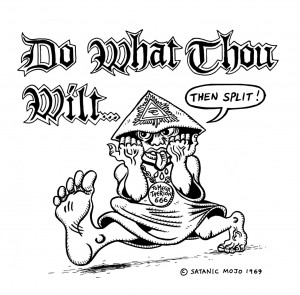 I know the drug issue is quite controversial but that is the nexus point that divides two of the major schools of modern Satanic thought. Those derived from Crowley and those of LaVey. As I am setting the Satanic Mojo project within my own lifetime – since 1967 – I could not ignore the LSD revolution, especially as the resultant psychedelic imagery changed the cultural landscape so much and so quickly. Without that influence we would not have, for example, the sensational graphics of Process magazine – the Process were very anti-drugs, as most cults are, the last thing you want when running a religion is for everyone to start thinking for themselves and questioning orders.
I know the drug issue is quite controversial but that is the nexus point that divides two of the major schools of modern Satanic thought. Those derived from Crowley and those of LaVey. As I am setting the Satanic Mojo project within my own lifetime – since 1967 – I could not ignore the LSD revolution, especially as the resultant psychedelic imagery changed the cultural landscape so much and so quickly. Without that influence we would not have, for example, the sensational graphics of Process magazine – the Process were very anti-drugs, as most cults are, the last thing you want when running a religion is for everyone to start thinking for themselves and questioning orders.
I recognise the dangers of drug use, but also appreciate the benefits. On an anthropological level I don’t believe there would even be any religion without the psychedelic experience. I have avidly read LaVey’s books and find myself agreeing with him on most counts. I think he was an incredibly astute man but that does not mean I share all the same opinions as him. It seems to me that LaVey’s criticism of hippies was based on a knee-jerk reaction to their aesthetic, but I think his distaste of their fashion may have blinded him to their cultural importance.
It is pretty much impossible these days to look back at the San Francisco/LA scene of the late 1960s and not see hippies, Manson, The Process Church, underground comix and so forth alongside the Church Of Satan. A quick look at the catalogue of Feral House – publishers of much of LaVey’s work – will show I’m not the only Satanist with an interest in such subjects.
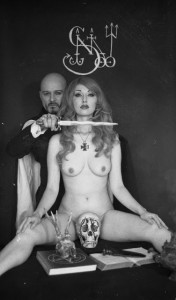 As LaVey demonstrated only so well it is often the salacious and prurient “Hammer Horror” type imagery that attracts people to Satanism in the first place. The early Church of Satan promotional shots are obviously aimed at exactly this section of the market. He used art by underground artist Coop – I’m not suggesting Coop is on drugs but there is direct connection between his artistic practice and the underground comix scene. His collaborations with – Crowleyan – Kenneth Anger or courtship of Marilyn Manson to publicise the Church, for example, are evidence that he saw the value in appealing to consumers of pop/underground culture. They may be attracted by blood and boobies but once they have gotten over the cheap thrills the hope is that few will stay and delve deeper into the true meaning of Satanism.
As LaVey demonstrated only so well it is often the salacious and prurient “Hammer Horror” type imagery that attracts people to Satanism in the first place. The early Church of Satan promotional shots are obviously aimed at exactly this section of the market. He used art by underground artist Coop – I’m not suggesting Coop is on drugs but there is direct connection between his artistic practice and the underground comix scene. His collaborations with – Crowleyan – Kenneth Anger or courtship of Marilyn Manson to publicise the Church, for example, are evidence that he saw the value in appealing to consumers of pop/underground culture. They may be attracted by blood and boobies but once they have gotten over the cheap thrills the hope is that few will stay and delve deeper into the true meaning of Satanism.
There seems to have been a surge of interest n what you might term psychedelic Satanism – trying to recreate the dark fringes of the 60s-70s occult fad as it should’ve been – particularly with hard rock bands such as Ghost and Electric Wizard. Why do you think it’s happening now, is it more than macabre nostalgia, and how do you fit into it all?
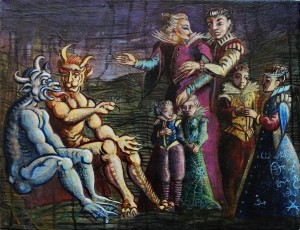 Macabre nostalgia is probably the basis for much of the imagery, but I also believe that this is merely a symptom of a craving for something more. Society is changing. I believe we are entering the Age Of Aquarius, or as Crowley called it, the Aeon Of Horus. The obsolete religious and political systems of the previous age are crumbling. The psychedelic/satanic imagery helps us to visualise this change.
Macabre nostalgia is probably the basis for much of the imagery, but I also believe that this is merely a symptom of a craving for something more. Society is changing. I believe we are entering the Age Of Aquarius, or as Crowley called it, the Aeon Of Horus. The obsolete religious and political systems of the previous age are crumbling. The psychedelic/satanic imagery helps us to visualise this change.
What do you hope to achieve with your Legend of Satanic Mojo project?
 The history of witchcraft and Satanism concerns people who questioned the status quo, who rebelled and sought their own way out from under a repressive control system. This is analogous to the teenager who rebels against parental control. The concept of the teenager is a relatively new one. Youth who make their own societies and codes, who question authority and rebel, have been routinely demonised by society as a whole but in the aftermath we see personal freedoms developing and society becoming more humanistic.
The history of witchcraft and Satanism concerns people who questioned the status quo, who rebelled and sought their own way out from under a repressive control system. This is analogous to the teenager who rebels against parental control. The concept of the teenager is a relatively new one. Youth who make their own societies and codes, who question authority and rebel, have been routinely demonised by society as a whole but in the aftermath we see personal freedoms developing and society becoming more humanistic.
Whereas Victorian children were often clad in miniature versions of the three-piece-suits grown-ups wore, the modern teenager has always striven to find their own style. The rise of pop culture is in many ways the history of the teenager, the rebels, the fashion tribes. Elvis’s hip-thrust was deemed indecent by TV, as were Mary Quant’s high-slashed mini skirts and long hair of the Beatles. From Hells Angels to Punks, Headbangers, Goths, Ravers or the hoodies of today, youth tribes have routinely been demonised, shunned or banned from the pubs. The main connecting thread between all of these is that from Rock ‘n’ Roll to Acid House, even comics and role-playing games, is that they have, at some point, been labelled as Satanic by a hysterical mass-media.
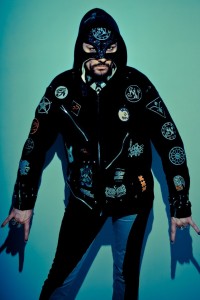 I think the history of pop culture, of the rise of the teenager, demonstrates a greater social change towards a new kind of society. That is what I want to document and encourage through this project. Assuming this first phase goes well, we are currently working on a set of artworks based on the hippy occult scene. An underground comic, a black light poster, t-shirts etc… Future phases of the project will examine the likes of Heavy Metal music, Video Nasties etc, as I work my way up through the decades to the present day. One piece I am currently working on, for example, is a Satanic hoodie, representing one of the more recent youth cults to be demonised.
I think the history of pop culture, of the rise of the teenager, demonstrates a greater social change towards a new kind of society. That is what I want to document and encourage through this project. Assuming this first phase goes well, we are currently working on a set of artworks based on the hippy occult scene. An underground comic, a black light poster, t-shirts etc… Future phases of the project will examine the likes of Heavy Metal music, Video Nasties etc, as I work my way up through the decades to the present day. One piece I am currently working on, for example, is a Satanic hoodie, representing one of the more recent youth cults to be demonised.
To learn more about Jason’s Satanic Mojo project, including how you can become involved and lay your hands on authentic artefacts from the mythic unholy cult via the indigogo scheme, click here.
